
Sceliphron caementarium, also known as the yellow-legged mud-dauber wasp, black-and-yellow mud dauber, or black-waisted mud-dauber, is a species of sphecid wasp. There are some 30 other species of Sceliphron that occur throughout the world, though in appearance and habits they are quite similar to S. caementarium.
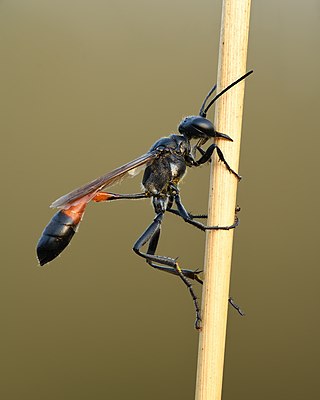
The Sphecidae are a cosmopolitan family of wasps of the suborder Apocrita that includes sand wasps, mud daubers, and other thread-waisted wasps.

Mud dauber is a name commonly applied to a number of wasps from either the family Sphecidae or Crabronidae which build their nests from mud; this excludes members of the family Vespidae, which are instead referred to as "potter wasps". Mud daubers are variable in appearance. Most are long, slender wasps about 1 inch (25 mm) in length. The name refers to the nests that are made by the female wasps, which consist of mud molded into place by the wasp's mandibles. Mud daubers are not normally aggressive, but can become belligerent when threatened. Stings are uncommon.

Bembix rostrata is a species of sand wasp native to Central Europe. The genus Bembix - of which B. rostrata is among the most distinctive species - has over 340 species worldwide and is found mostly in warm regions with open, sandy soils; Australia and Africa have a particularly rich variety of species.

The subfamily Crabroninae(digger wasps) is the most diverse group in the wasp family Crabronidae, containing over 110 genera and 4,800 described species. The subfamily consists of solitary, predatory wasps. The adult females of many groups dig tunnels in the ground for nesting, but others use different techniques, including the construction of tube-like mud nests.

Crabronini is a tribe of square-headed wasps in the family Crabronidae. There are 48 genera and over 1,500 described species in Crabronini. Wasps of this tribe are mostly small to very small wasps. Typical of this tribe are the forewings with a single submarginal cell, the lack of membranous metanotal and propodeal modifications, and a square-shaped head.

Sphex ichneumoneus, known commonly as the great golden digger wasp or great golden sand digger is a wasp in the family Sphecidae. It is identified by the golden pubescence on its head and thorax, its reddish orange legs, and partly reddish orange body. This wasp is native to the Western Hemisphere, from Canada to South America, and provisions its young with various types of paralyzed Orthoptera.
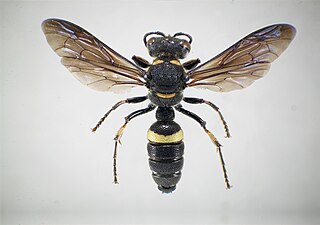
Cerceris fumipennis, the only species of buprestid-hunting Philanthidae occurring in eastern North America, is found throughout the continental United States east of the Rockies: from Texas and Florida north to Maine, Wyoming, and into Canada. The wasps most often nest in open areas of hard-packed sandy soil surrounded by woody habitat suitable for their buprestid beetle prey.
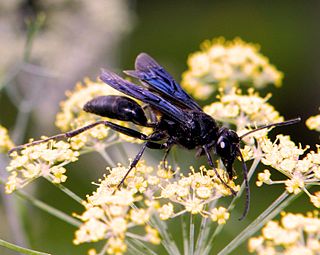
Sphex pensylvanicus, the great black wasp, is a species of digger wasp. It lives across most of North America and grows to a size of 20–35 mm (0.8–1.4 in). The larvae feed on living insects that the females paralyze and carry to the underground nest.

Isodontia mexicana, the Mexican grass-carrying wasp, is a species of insect belonging to the family Sphecidae. It is mainly found throughout North America, but has become established in Europe, primarily France, Switzerland, Hungary, Italy, Serbia, and Spain.

Sphecius grandis, also called the western cicada killer, is a species of cicada killer wasp (Sphecius). The western species shares the same nesting biology as its fellow species, the eastern cicada killer. S. grandis, like all other species of the genus Sphecius, mainly provides cicadas for its offspring. It forms nest aggregations and mates and broods once in a year, in July and early August. The wasp is on average 3 cm (1 in) to 5 cm (2 in) in length and is amber-yellow with yellow rings on its abdomen.
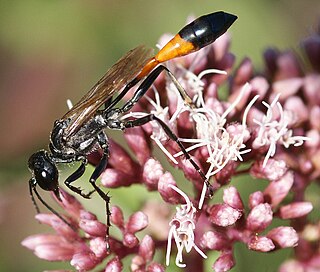
Ammophila sabulosa, the red-banded sand wasp, is a species of the subfamily Ammophilinae of the solitary hunting wasp family Sphecidae, also called digger wasps. Found across Eurasia, the parasitoid wasp is notable for the mass provisioning behaviour of the females, hunting caterpillars mainly on sunny days, paralysing them with a sting, and burying them in a burrow with a single egg. The species is also remarkable for the extent to which females parasitise their own species, either stealing prey from nests of other females to provision their own nests, or in brood parasitism, removing the other female's egg and laying one of her own instead.
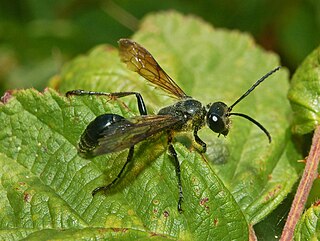
Isodontia is a genus belonging to the family Sphecidae. Adults emerge from their cocoons in early summer, and usually make nests lined with grass or hay in hollow plant cavities. This has led to their common name being grass-carrying wasps. The larvae are often fed Orthoptera that the adult has paralyzed.

Isodontia elegans, also known as the elegant grass-carrying wasp, is a species of solitary, nest-provisioning, thread-waisted wasp in the family Sphecidae that hunts orthopterans.

Ammophila placida is a species of thread-waisted wasp in the family Sphecidae. It is found in the continental United States and Central America.

Ammophila azteca is a species of thread-waisted wasp in the family Sphecidae. It is native to Canada, Mexico, and the continental United States. It is found from near-sea level to over 6,000 feet in altitude.
Isodontia apicalis is a species of thread-waisted wasp in the family Sphecidae from North and Central America.

Ammophila procera, the common thread-waisted wasp, is a species of thread-waisted wasp in the family Sphecidae. It is a common species, found in southern Canada, the United States, and Mexico, and south to Central America.
Philanthus lepidus is a species of wasp in the family Philanthidae. It is found in North America. It creates false burrows in its nests, and preys upon Halictidae bees.

Palmodes occitanicus is a species of thread-waisted wasp in the family Sphecidae.

















